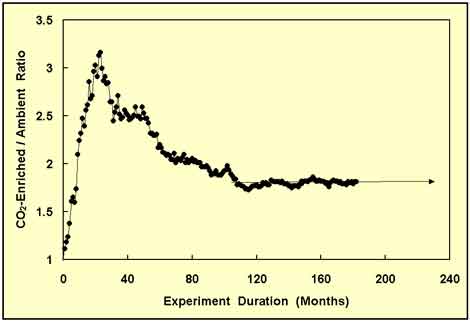Volume 14, Number 51: 21 December 2011
In the abstract of his recent study (Local adaptation to temperature conserves top-down control in a grassland food web), Barton (2011) writes that "a fundamental limitation in many climate change experiments is that tests represent relatively short-term 'shock' experiments and so do not incorporate the phenotypic plasticity or evolutionary change that may occur during the gradual process of climate change," and he notes that "capturing this aspect of climate change effects in an experimental design is a difficult challenge that few studies have accomplished."
Barton notes, for example, that the vast bulk of current experimental approaches to this problem "generally manipulate climate variables (e.g. temperature, precipitation, nitrogen deposition, etc.) to simulate conditions predicted by global change models," and he rightly states that "a limitation of this approach is that relatively short-term 'shock' experiments may not accurately test how a long term, chronic effect, such as climate change, will affect ecological communities." Thus, he concludes that "extrapolating the effects of gradual climate change from short-term experiments that test future climate scenarios on extant systems may be misleading," citing as evidence for the validity of this statement the studies of Chapin et al. (1995), Korner (2006), Suttle et al. (2007) and Clark and Tilman (2008).
So how is this difficulty to be overcome? One way is to conduct lengthy experiments, such as the long-term Phoenix, Arizona (USA) sour orange tree study (Idso and Kimball, 2001; Kimball et al., 2007). As can be seen in the figure below depicting the CO2-enriched/ambient-treatment ratio of above-ground woody biomass, for example, it took a full decade before what appears to be a final stable growth-enhancement result was ultimately achieved.

In another approach that deals with parameters that vary significantly from place to place on the surface of the earth, Barton writes that "the potential role of adaptation to climate change could be inferred from a space-for-time substitution using a transplant experiment," citing the work of Fukami and Wardle (2005). Although he notes that "this experimental strategy does not test the role of evolution directly, it explicitly accounts for within-species variation arising under different climate histories and how this might influence community-level responses to climate change."
In his own study of a grassland food web, Barton "examined the effect of temperature and predator climate history in food webs composed of herbaceous plants, generalist grasshopper herbivores and spider predators across a natural 4.8°C temperature gradient spanning 500 km in northeastern USA," where "the effects of rising temperatures on the plant community are indirect and arise via altered predator-herbivore interactions." And in using this approach, he determined that "variation in predator response to warming may maintain species interactions and associated food web processes when faced with long term, chronic climate warming."
In further commentary on his findings, Barton says his study "demonstrates that physiological and behavioral responses of predators to local climates can maintain food web function across a range of temperatures similar to that predicted by global change models," and he indicates that "this conclusion differs markedly from the predominant view in the literature that species responses may alter, but not attenuate, the effects of climate change." Thus, he concludes that "it is the responsibility of ecologists to design experiments that explicitly test how gradual climate change will affect future systems, or else risk making unrealistic and misleading conclusions."
Sherwood, Keith and Craig Idso
References
Barton, B.T. 2011. Local adaptation to temperature conserves top-down control in a grassland food web. Proceedings of the Royal Society B 278: 3102-3107.
Chapin, F.S., Shaver, G.R., Giblin, A.E., Nadelhoffer, K.J. and Laundre, J.A. 1995. Responses of Arctic tundra to experimental and observed changes in climate. Ecology 76: 694-711.
Clark, C.M. and Tilman, D. 2008. Loss of plant species after chronic low-level nitrogen deposition to prairie grasslands. Nature 451: 712-715.
Fukami, T. and Wardle, D.A. 2005. Long-term ecological dynamics: reciprocal insights from natural and anthropogenic gradients. Proceedings of the Royal Society B 272: 2105-2115.
Idso, S.B. and Kimball, B.A. 2001. CO2 enrichment of sour orange trees: 13 years and counting. Environmental and Experimental Botany 46: 147-153.
Kimball, B.A., Idso, S.B., Johnson, S. and Rillig, M.C. 2007. Seventeen years of carbon dioxide enrichment of sour orange trees: final results. Global Change Biology 13: 2171-2183.
Korner, C. 2006. Plant CO2 responses: an issue of definition, time and resource supply. New Phytologist 172: 393-411.
Suttle, K.B., Thomsen, M.A. and Power, M.E. 2007. Species interactions reverse grassland responses to changing climate. Science 315: 640-642.




